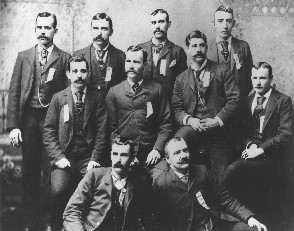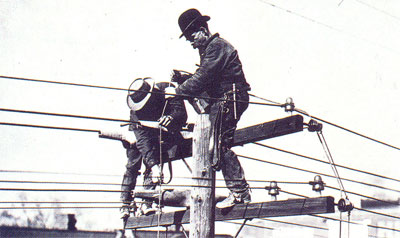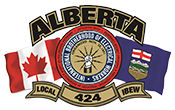I.B.E.W. History
In order to get a sense of what our union is about, we need to look at our past. The surge toward unionism was born out of the electrical workers’ desperate social and financial needs and deplorable safety conditions.
In the United States, beginning in 1870, there were some unsuccessful attempts by courageous linemen and wiremen to form unions. They worked 12-hour days, seven days a week, for 15 to 20 cents an hour; $2.50 a day was the top pay for linemen, and many men were forced to accept work for $8 a week. They occupied the bottom rung of the workers’ social ladder.
There were no apprenticeship training programs or safety standards. One out of every two linemen hired was killed within five years. This death rate was twice that of the national average for all other industries. Their only solution was to form a union.
Henry Miller was a lineman from St. Louis, Missouri, who "rode the rails" with his tools. He traveled to many cities of the United States to work at the  trade. Along the way he organized the electrical workers he met and worked with into local unions. In 1891 Henry Miller and nine other delegates representing about 300 workers met in a small room above Stolley’s Dance Hall in St. Louis and adopted the name of “National Brotherhood of Electrical Workers” (NBEW) and drafted our first Constitution. With the addition of Canadian members in 1899, by the chartering of the first Canadian local union, the NBEW became international and changed its name to the “International Brotherhood of Electrical Workers” (IBEW).
trade. Along the way he organized the electrical workers he met and worked with into local unions. In 1891 Henry Miller and nine other delegates representing about 300 workers met in a small room above Stolley’s Dance Hall in St. Louis and adopted the name of “National Brotherhood of Electrical Workers” (NBEW) and drafted our first Constitution. With the addition of Canadian members in 1899, by the chartering of the first Canadian local union, the NBEW became international and changed its name to the “International Brotherhood of Electrical Workers” (IBEW).
Our union, which began with fewer than 2,000 members, has grown to almost 780,000 strong in the United States and Canada. Instead of 10 local unions, there are now over 1,000 local unions representing members in many fields, including Construction and Maintenance, Utility, Telecommunications, Railroad, Broadcasting and Recording, Manufacturing, and Government.
For an organization so large to effectively function, a structure must be in place. The founders built an enduring structure-the IBEW Constitution.
We’ve always been there – for Canada – and for you
The late 1800s saw a huge surge in public demand for electricity. That meant the need for more and more electrical workers. But back then, employers didn’t really care about employee safety.Hardhats? Who needs them? Safety harnesses? What’s a harness? No training? Who needs training?
Electrical workers spent 12 hours a day, seven days a week connecting and repairing power lines with no safety mechanisms in place. None at all.
And they did so even in rain. Snow. Hail. Lightning. And whatever else Mother Nature decided to throw at them.
That’s all good if you’re working indoors. But dozens of feet above the ground with little regard for safety? Scary is an understatement.
It gets better – or worse, actually. They did all this without the skills-training they needed to do the job right. So on November 28, 1891, the National Brotherhood of Electrical Workers was founded in St. Louis, Missouri, representing 286 members employed in the electrical industry. The goal? To look out for the people doing one of the toughest jobs in the country.
It wasn’t long before the NBEW’s commitment to keeping people safe moved north. On December 20, 1899, the Canadian arm of the NBEW set roots down in Ottawa, and at the sixth convention in 1899 the name was changed from the National Brotherhood of Electrical Workers to the International Brotherhood of Electrical Workers.
Today, we represent over 70,000 members from coast to coast to coast – in every province and territory. And as the country advanced into new electronic technologies, we did too. We now represent members in all kinds of industries, including utilities, manufacturing, construction, telecommunications, cable, radio and television, shipyards, railroads, sound and alarm, appliance repair, motor shops, sign shops, pulp and paper mills, mining, and government.
And while the size of our brotherhood has changed, our commitment to keeping our brothers and sisters safe and highly skilled, and being there for the country, 24/7, 365 days a year (and 366 days on leap years) will never waver.
IBEW Local 424 History
1928 June 1st IBEW Local Union 424 is organized by 11 Railway workers
1930 Our first election is held and Nelson Kitchen is elected Business Manager
1940’s Rate of pay is $1.15 per hour
1947 Due to organizing by Dave Kier, Local 424 grows to 600 members
1951 First mega project begins - Chemcell plant
1952 Suggestion made to the executive to purchase group hospitalization insurance
1961 A committee is appointed to organize a benefit fund
1965 Construction begins on the Great Canadian Oil Sands Plant (Suncor)
1967 An all-weather road is completed to Fort McMurray
1969 Almost 90% of all Alberta electricians work under an IBEW collective agreement
1971 After 20 years of deliberations we receive our Pension, Health and Welfare benefits
1975 Strike - the first in our history- lasting 3 months. The issues were: apprenticeship ratios, wages and retro-active pay
1976 Boom years. Government limits pay raises to 6% - inflation was at 12%
1977 LU 424 Education Trust begins training for the members
1982 Union pay rate is $21.36 per hour
1983 3500 Build trades members gather outside Legislature to protest Bill-110
1984 Labour Board allows companies to become Double-Breasted
1984 Market share drops from 70% to 10% after 24 hr. Lockouts
1988 Alberta updates Labour Code legalized Dual Shop/Double-Breasting
1991 Local 424 hires full time organizers to begin rebuilding
1992 RRSP program is instituted to supplement the pension plan
1993 Market Recovery Trust Fund established to allow members to work at full union rate and capture more of the market share
1998 LU 254 (Southern Alberta) construction electricians amalgamate with LU 424, making 424 a province-wide local
1999 LU 424 grows to 3500 members with a good work picture
2003 Growth continues as work picture improves - now more than 5000 members
2004 CNRL signs a division 8 agreement with Alberta Government -uses CLAC for their manpower
2005 Membership reaches over 6000
2017 Local 424 signs first Residential agreement with ECAA
2017 Government of Alberta passes Bill-17 allowing Automatic Certification at 65%




